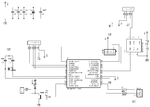markdem
Member level 3
Hi All,
I have a odd issues driving some fans using PWM from my PIC.
Fan details are : 12v 200mA 2 wire. PWM frequency 20khz.
If I connect 1 fan to the circuit everything works fine. Problem is I need 2 fans to be driven.
When I connect the second fan (Same type, manufacture etc) I get the following results;
At 12v and 100% duty fans work fine.
At 12v and any other duty (except 0%) the PICs oscillator will stop.
At voltages <10v the fans will work fine except for duties between 88% and 92%. If I select these duties the PWM output will go to 0v after about 1 second. The PIC keeps working as I can send it commands.
I can connect 1 larger fan (600mA) and it will work fine so I am guessing it is not a current issue.
I have also tried a different pair of fans (from a different manufacture) and get the same results.
I don't have a pair of 3 wire fans so I can test that.
Anyone have any ideas what could be doing this, or what else I can test\try?
Thanks
I have a odd issues driving some fans using PWM from my PIC.
Fan details are : 12v 200mA 2 wire. PWM frequency 20khz.
If I connect 1 fan to the circuit everything works fine. Problem is I need 2 fans to be driven.
When I connect the second fan (Same type, manufacture etc) I get the following results;
At 12v and 100% duty fans work fine.
At 12v and any other duty (except 0%) the PICs oscillator will stop.
At voltages <10v the fans will work fine except for duties between 88% and 92%. If I select these duties the PWM output will go to 0v after about 1 second. The PIC keeps working as I can send it commands.
I can connect 1 larger fan (600mA) and it will work fine so I am guessing it is not a current issue.
I have also tried a different pair of fans (from a different manufacture) and get the same results.
I don't have a pair of 3 wire fans so I can test that.
Anyone have any ideas what could be doing this, or what else I can test\try?
Thanks
